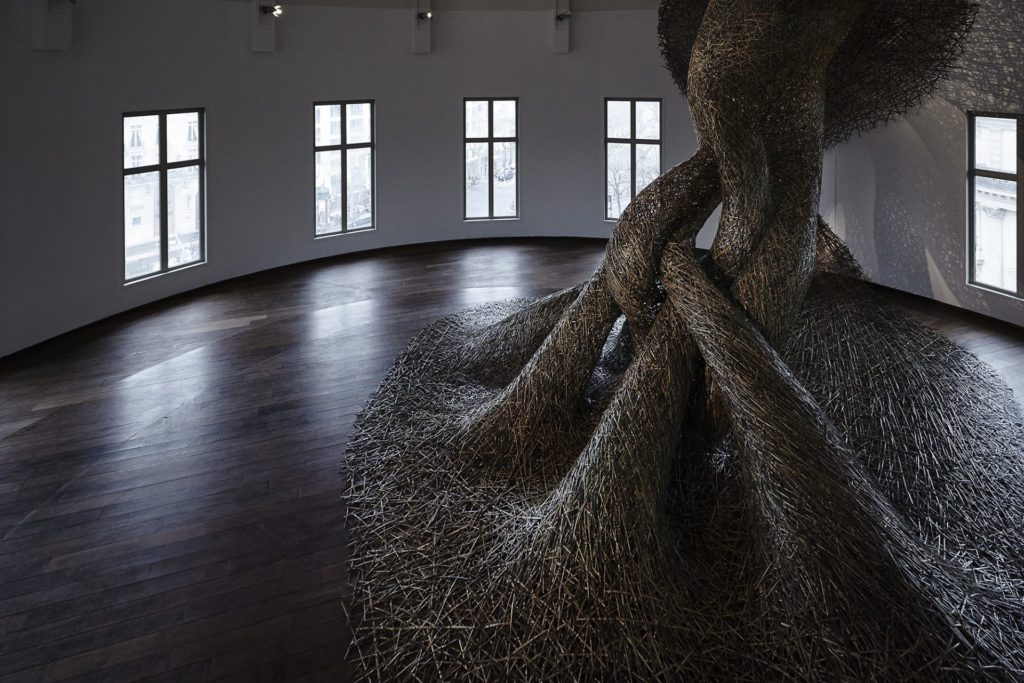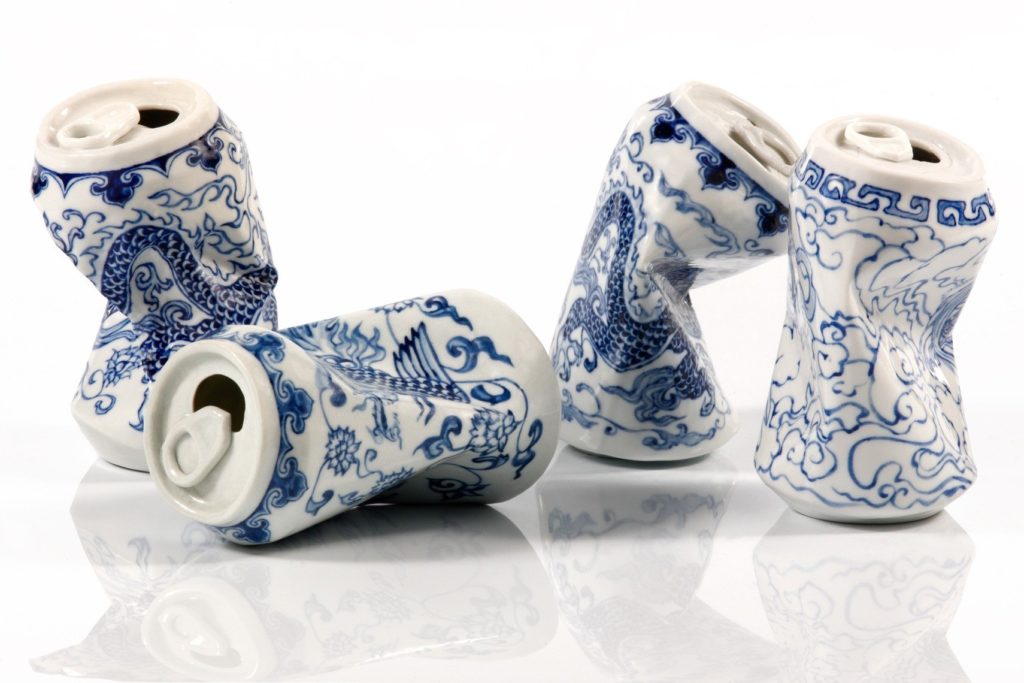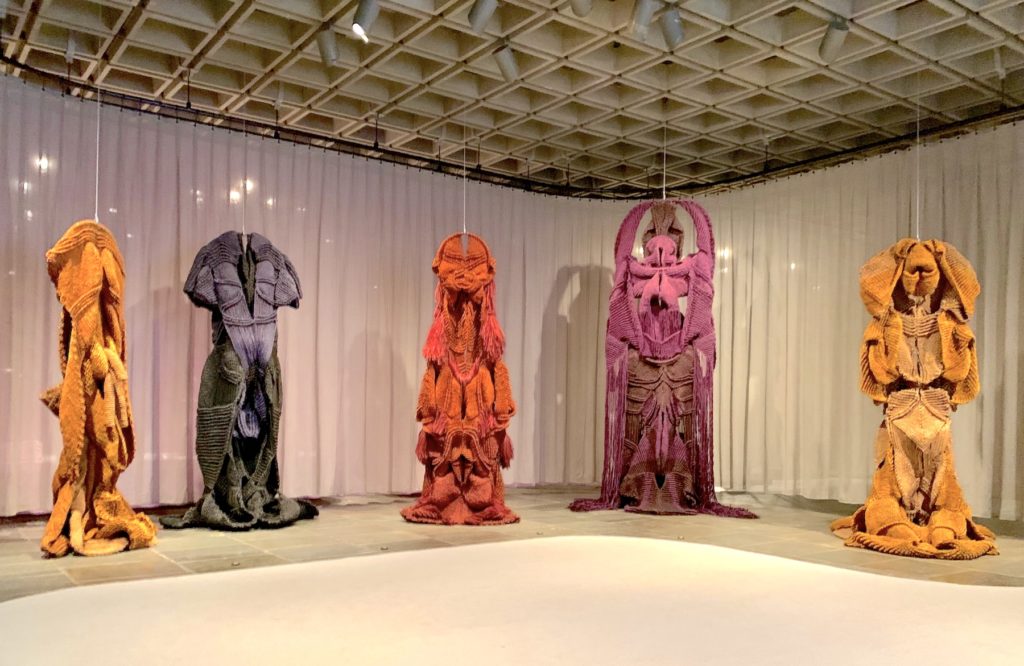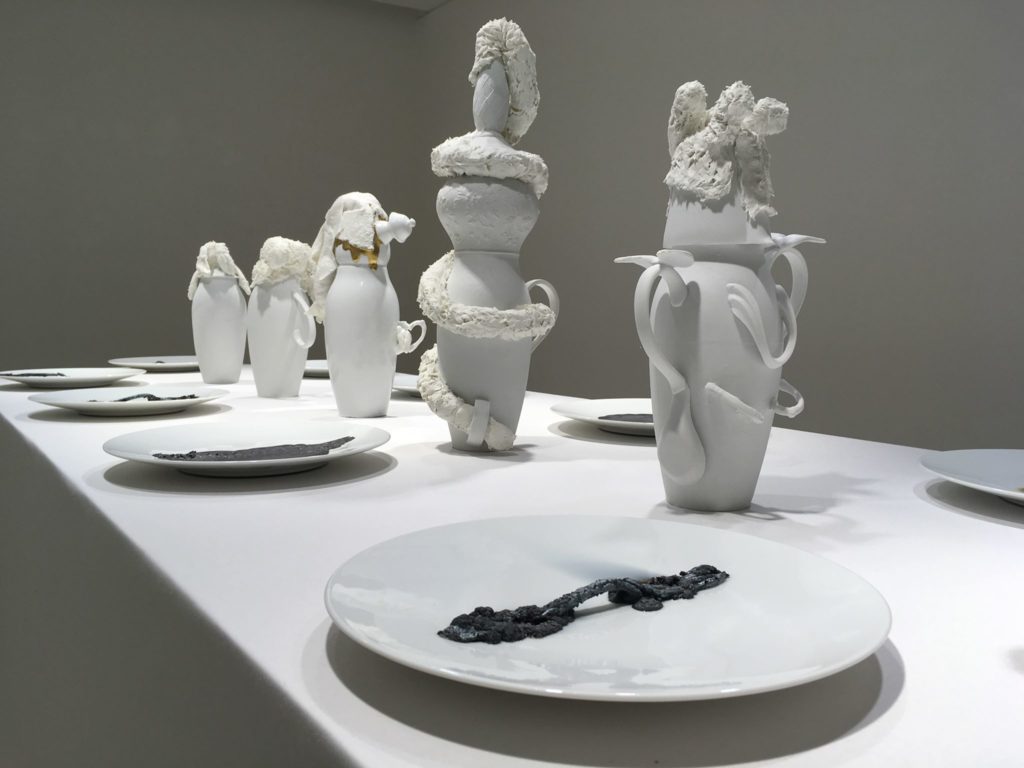Reviving traditions through contemporary material culture is a challenge faced by numerous Asian artists. Guardians of an heritage made of ancestral know-how that can only be passed from person to person to survive, their creations reflect a desire to renew art while being inspired by the past which shaped their identity. Ceramics, wickerwork, bamboo arts, statuary and traditional weaving and dying techniques are revisited by artists Zhuo Qi, Lei Xue, Yuki Nara, Chikuunsai Tanabe IV, Sopheap Pich and Mrinalini Mukherjee.
ACA project has selected these artists to echo the edition #21 of Koï magazine, with a special issue on « Heritage ».
Faire vivre les traditions au travers de la culture matérielle contemporaine est un défi relevé par de nombreux artistes asiatiques. Gardiens d’un héritage reposant sur la transmission de savoirs ancestraux, leurs créations sont le reflet d’une volonté de renouveler l’art tout en s’appuyant sur un passé riche et inhérent à leur identité. Céramique, vannerie, statuaire et techniques de tissage traditionnelles sont revisitées par Zhuo Qi, Lei Xue, Yuki Nara, Chikuunsai Tanabe IV, Sopheap Pich et Mrinalini Mukherjee.
Ces artistes sont sélectionnés par ACA project, en écho à l’édition #21 du magazine Koï, sur le thème « Héritage ».
CHIKUUNSAI TANABE IV

“Tradition should be challenged”, this mantra, passed through the generations of the Tanabe family, means that tradition should not be fixed, but integrated as part of contemporaneity. Chikuunsai Tanabe IV was born in 1973 in Sakai, near Osaka, in a family of craftsmen who has been working the bamboo for 120 years. Only working with bamboo, he uses it to make two types of creation – monumental installations and works of ancestral basketry – in which he integrates his very contemporary vision. Although famous all around the world today, his path was full of pitfalls. Tanabe grew up surrounded by bamboos, watching his grand-father and father perpetuating the family’s tradition. He was educated in Japanese traditional arts, floral art, calligraphy and dance. It is in high-school, from his sculpture teacher, that he learned how to free himself from the weight of tradition. Leaving the family heritage, he went to Tokyo’s School of Fine Art, to meet his own way. But when he learned that his older brother would not keep up with the family tradition, he decided to perpetuate the work of his ancestors. After two years of formation in the art of bamboo, he became his father’s apprentice, and after 15 years of work, he earned the title of master craftsman. In his monumental bamboo installations, Tanabe is willing to express how this material makes him feel. He uses the lightness, the strength and the flexibility of the bamboo, while letting the material express itself. He doesn’t use glue nor nails in the constructions, but braids the bamboo strips. Working this way enables him to reuse more than 90% of the bamboo for his next installation. Therefore, his creations still contain the firsts strips of bamboo he was using eight years ago. Continuity and transmission are at the core of Chikuunsai Tanabe IV’s work. He is represented by Galerie Mingei in Paris, and currently exhibited at Musée Guimet, Paris, until May 3rd 2021.
“La tradition doit être réinventée », ce précepte transmis de génération en génération chez les Tanabe signifie que la tradition ne doit pas rester figée, et se doit d’intégrer une part de contemporanéité. Chikuunsai Tanabe IV est né en 1973 dans une famille d’artisans de Sakai, près d’Osaka, qui travaillent le bambou depuis 120 ans. Il utilise exclusivement le bambou pour réaliser deux types de création – des installations monumentales et des pièces de vannerie ancestrale – auxquels il apporte une vision contemporaine. Bien qu’aujourd’hui célébré à travers le monde, il n’a pas suivi un chemin facile. Tanabe a grandi entouré de bambous, observant son grand-père et son père perpétuer la tradition familiale. Il a été formé aux arts ancestraux japonais, à l’ikebana (art floral), à la calligraphie et à la danse. C’est par son professeur de sculpture au lycée qu’il apprend à se libérer de la tradition. Délaissant l’héritage familial, il part étudier aux beaux-arts de Tokyo pour suivre sa voie. C’est en apprenant que son grand frère ne reprendrait pas le flambeau de la vannerie de ses ancêtres, que Tanabe décide de ne pas rompre la lignée de cet héritage. Après deux ans de formation, il devient l’apprenti de son père, et hérite du titre de maître artisan après 15 ans de travail. Dans ses œuvres monumentales en bambou, Tanabe tente d’exprimer et de faire ressentir les sentiments que fait naître en lui ce matériau. Il met la flexibilité, la résistance et la légèreté du bambou au service de sa création, tout en laissant le matériau s’exprimer et prendre sa place. Dans ses installations il n’utilise ni colle, ni clous ; il tresse les lattes de bambou. Cela lui permet de réutiliser plus de 90% des bambous pour de nouvelles installations. Ainsi ses dernières œuvres contiennent encore les premières lattes de bambous qu’il tressait huit ans auparavant. La continuité et la transmission sont au cœur du travail et de l’œuvre de Chikuunsai Tanabe IV. Il est représenté par la Galerie Mingei à Paris, et exposé au Musée Guimet jusqu’au 3 mai 2021.
Shoko Moreau-Hayashi
LEI XUE

Born in 1974, Chinese artist Lei Xue first studied oil painting in Shandong before moving to Germany, where he attended Kassel School of Art and Design. From the traditional technics of watercolor on rice paper and scroll paintings to contemporary video installations, the artist jumps across eras by a wide range of media. Projected at numerous film festivals, Moment by Moment is one example of his productions perpetuating his homeland emblematic know-how into the modern spectra. The short animation presents black ink shapes, characteristic of the long-established zen landscape painting praxis, slowly transforming into an erratic race through an abstract urban setting. However, his best-known demonstration of the tension between past and modern times lays into glazed clay. Re-interpreting the Yuan and Ming dynasties’ famous white and blue porcelains, Lei Xue created a series of hand-painted vessels intertwining classical patterns and subversives illustrations of iconic American cartoons. Through the lens of a dialogue between East and Western iconographies and beyond aesthetic anachronism, the artist stresses out the effects of the Chinese cultural revolution on the traditional heritage, roamed by the influence of technology and industrial productions. The same theme is also embedded into the crushed enamel cans from his series: Drinking tea (2014). Lei Xue confronts the slowness, ancestral and meditative, of the tea ceremony, to the expeditious way of today’s consumerism, thereby implementing underlying considerations, such as the evolution of consumption modes and tools behinds basic human needs like hydration.
Né en 1974, l’artiste chinois Lei Xue a d’abord étudié la peinture à l’huile dans le Shandong avant de s’installer en Allemagne où il fréquente l’Ecole d’Art et de Design de Kassel. Des techniques traditionnelles de l’aquarelle sur papier de riz et des peintures sur rouleau aux installations vidéo contemporaines, l’artiste passe d’une époque à une autre grâce à un large éventail de médiums. Projeté à de nombreux festivals, Moment by Moment est un exemple de ses productions perpétuant dans le spectre de la modernité le savoir-faire de son pays natal. La courte animation présente ainsi des formes à l’encre noire, caractéristiques de la longue pratique établie de la peinture zen de paysage, qui se transforment lentement en une course erratique dans un décor urbain abstrait. Mais sa démonstration la plus connue de la mise en tension entre les temps passés et modernes repose dans de l’argile glacée. Réinterprétant les célèbres porcelaines blanches et bleues des dynasties Yuan et Ming, Lei Xue a créé une série de vaisselles peintes à la main, mêlant motifs classiques et illustrations subversives de dessins animés américains iconiques. Au-delà de l’anachronisme esthétique et à travers le prisme d’un dialogue entre iconographies orientales et occidentales, l’artiste souligne les effets de la révolution culturelle chinoise sur un patrimoine traditionnel, parcouru par l’influence de la technologie et des productions industrielles. Le même thème est aussi le corps des canettes écrasées émaillées de sa série : Drinking tea (2014). Lei Xue y confronte la lenteur, ancestrale et méditative, de la cérémonie du thé, à la voie expéditive du consumérisme d’aujourd’hui, mettant ainsi en œuvre des considérations sous-jacentes, telles que l’évolution des modes et des outils de consommation derrière les besoins humains fondamentaux comme l’hydratation.
Elodie Lafaurie-Bianchi
MRINALINI MUKHERJEE

Mrinalini Mukherjee (1949–2015) was an Indian contemporary artist, known for her groundbreaking and sexual sculptures made of fiber – such as natural or hand-dyed ropes woven from hemp, which are easy to obtain in the local market of India-, ceramic and bronze. The sculptures she created took totemic, biomorphic forms that seem to be influenced by nature, traditional Indian folk art and Indian mythology. She chose to never work based on sketches, but only using her intuitive laborious process of working, such as traditional technique, knotting, with her hands. While abstract forms of fiber art emerged in the West in the 1960s and 1970s, the artist stuck to her modernist formalism style. Mrinalini Mukherjee received a Bachelor degree in painting from Maharaja Sayajirao University, Baroda, followed by a post-diploma degree in mural design at the same university, under her father’s former student K. G. Subramanyan, one of the first experimental Indian artists. It is said that he encouraged her to engage with the historical Indian artistic and craft traditions, and to try unconventional materials and techniques. In 1978, Mrinalini Mukherjee was awarded the British Council scholarship for culture, which allowed her to study at West Surrey College of Art and Design in Farnham, UK. There, she continued her experimentation with dyed hemp, and started to gain reputation. Mrinalini Mukherjee passed away suddenly at the age of 65. Many exhibitions and research have been taking place to commemorate her work and re-examine her world, such as the exhibition « Phenomenal Nature » in 2019 at the Metropolitan Museum (New York).
Mrinalini Mukherjee (1949–2015) était une artiste contemporaine indienne, connue pour ses sculptures révolutionnaires et sexuellement évocatrices fabriquées à partir de fibres – notamment celles de chanvre tissé naturelles ou teintes à la main, faciles à obtenir sur le marché local en Inde -, de céramique et de bronze. Elle a donné à ses créations des formes totémiques et biomorphiques qui semblent être influencées par la nature, l’art populaire indien traditionnel et la mythologie indienne. Se refusant à travailler à partir de croquis, l’artiste a uniquement suivi un processus de travail intuitif et laborieux à l’origine de chacune de ses pièces, comme la technique traditionnelle de nouage avec ses mains. Alors que des formes abstraites d’art textile ont émergé en Occident dans les années 1960-1970, la jeune femme choisit de rester fidèle à son style de formalisme moderniste. Mrinalini Mukherjee a obtenu un premier diplôme en peinture de l’université Maharaja Sayajirao, à Baroda, puis un post-diplôme en design mural à la même université, sous la direction de l’ancien étudiant de son père, K. G. Subramanyan, l’un des premiers artistes expérimentaux indiens. Ce dernier l’aurait encouragée à engager son travail dans les traditions artistiques et artisanales indiennes et à explorer des matériaux et des techniques non conventionnels. En 1978, Mrinalini Mukherjee a reçu la bourse du British Council pour la culture, qui lui a permis d’étudier au West Surrey College of Art and Design à Farnham, au Royaume-Uni. Là, elle a continué ses expérimentations avec la fibre de chanvre teint et a commencé à gagner en réputation. Mrinalini Mukherjee est décédée subitement à l’âge de 65 ans. De nombreuses expositions et recherches sont en cours pour commémorer son travail et réexaminer son univers, comme en témoigne l’exposition «Phenomenal Nature» en 2019 au Metropolitan Museum (New York).
Hyojin Cho
SOPHEAP PICH

Sopheap Pich is a Cambodian-American artist, born in a small village, Battambang, in Cambodia in 1971. Together with his family, he fled to Thailand in 1979, and immigrated to the United States in 1984. Sopheap Pich is well known for his use of traditional Cambodian local materials – such as bamboo, rattan, burlap, beeswax and earth pigments – to create sculptures. He naturally learned these craft skills from his father at his young age, while he was making fish traps and weave baskets. His elaborate artworks reflect the history and culture of Cambodia, his childhood memories of them, and the duality of his identity between Cambodia and America. After pre-med studies, Sopheap Pich started to study art and received his BFA in painting from the University of Massachusetts at Amherst in 1995 and an MFA in painting from the School of the Art Institute of Chicago in 1999. Soon after graduation, he returned to Cambodia in 2002, as he was not sure how to pursue his career as an artist in America. In his native country, he recalled his childhood memories, whether they were happy or dark, and he started to express them into sculptures with natural materials he could easily get around him, making diverse figures he had seen and experienced in his childhood. The imagery of his first sculpture “Silence” (2004), an interconnected pair of lung-shaped forms, was inspired by his medical book to represent the complicated feeling about his identity. As for “The Morning Glory” (2011), this piece commemorates the « morning glory » (a traditionnel dish): the most important source of nourishment for Cambodian during the Khmer Rouge regime. His sculpture “Buddha 2” (2009) shows a broken buddha he has seen in his childhood in a temple covered with bloodstains on the floor, ceiling, and walls. Recently, Sopheap Pich has started to explore the form of grid made with bamboo strips and natural pigments.
Sopheap Pich est un artiste américain-cambodgien, né dans le petit village de Battambang au Cambodge, en 1971. Avec sa famille, il a fui en Thaïlande en 1979, avant d’immigrer aux États-Unis en 1984. Sopheap Pich est célèbre pour son utilisation de matériaux locaux traditionnels cambodgiens – tels que le bambou, le rotin, la toile de jute, la cire d’abeille et les pigments naturels – pour la création de ses sculptures. C’est très jeune, de son père, qu’il a naturellement appris ce savoir-faire artisanal, alors qu’il fabriquait des pièges à poissons et tissait des paniers. Ses œuvres d’art élaborées reflètent l’histoire et la culture du Cambodge, ses souvenirs d’enfance et la dualité de son identité entre le Cambodge et les Etats-Unis. Après des études préparatoires de médecine, Sopheap Pich s’oriente vers des études artistiques et obtient un premier diplôme en peinture de l’Université du Massachusetts à Amherst en 1995 et un second de la School of the Art Institute of Chicago en 1999. Peu de temps après la fin de ses études, ne sachant pas comment poursuivre sa carrière d’artiste aux Etats-Unis, il retourne au Cambodge en 2002. Dans son pays natal, il se remémore ses souvenirs d’enfance, qu’ils soient heureux ou sombres, et commence à les exprimer sous la forme de sculptures fabriquées avec des matériaux naturels locaux, recréant des figures de son enfance. L’imagerie de sa première sculpture «Silence» (2004), qui évoque une paire de poumons interconnectée, est inspirée de son livre de médecine pour représenter la complexité de ses sentiments vis-à-vis de son identité. Quant à son oeuvre «The Morning Glory» (2011), elle commémore la « gloire du matin » (un plat traditionnel cambodgien): la plus importante source de nourriture pour les Cambodgiens sous le régime des Khmers rouges. Sa sculpture «Bouddha 2» (2009) montre un bouddha brisé qu’il a vu dans son enfance au sein d’un temple dont le sol, le plafond et les murs étaient couverts de sang. Récemment, Sopheap Pich a commencé à explorer la forme de la grille tressée à partir de bandes de bambou et de pigments naturels.
Hyojin Cho
YUKI NARA

« Before creating an artwork, I ask myself how to create an artwork that only I can make in the time in which we live. What comes up is an artwork of liberty which has no border.” Yuki Nara (b. 1989) is the oldest son of the 11th generation of Ohi Chozaemon, a famous family of ceramists for about 350 years. Although born in a famous family of ceramists from the Edo era, Yuki Nara didn’t want to touch the clay and to become a ceramist. After high school, he studied architecture at the Tokyo University of Arts. When he wondered how to enrich his career path as an architect, he decides to face his roots, and to take an absence of 2 years to learn the ceramic technique at the Tajimi City Pottery Design and Technical Center. Thanks to this decision, his creation are influenced by both architecture and ceramic. The « Bone Flower’s » series reflects perfectly his pathway between architect and ceramist. Yuki Nara uses his talent to create sculptures with complexe and innovative shapes. Made of several layers, glazed with whitish skin tone, these shapes become more organic and get animated by the play of lights and shadows. His work on patterns, repetition and spacing, is much evocative of the Japanese architectural spirit. A young talented ceramist, Yuki Nara has already achieved mature work. His original approach makes him stand out from the crowd of contemporary artists. An exhibition of his work will take place at the Galerie Mikiko Fabiani in Paris in 2021.
“Avant de créer une œuvre, je cherche toujours au fond de moi quel est le sujet qui est le plus singulier et personnel, et inscrit dans notre époque. Ce qui me vient en tête est une œuvre libre et sans frontière. » Yuki Nara (né en 1989) est le fils aîné de la 11ème génération de Ohi Chozaemon, famille de céramistes depuis environ 350 ans. Bien que né dans une famille célèbre pour ses céramiques Ohi depuis l’époque d’Edo, Yuki Nara n’aspirait pas à devenir céramiste, ni même à toucher à la terre. Après son lycée, il part pour l’université des beaux art de Tokyo pour étudier l’architecture. Avant la fin de ses études, le désir de se rapprocher de ses racines, afin d’enrichir son travail d’architecte, vient le cueillir. Il arrête temporairement ses études et se forme à la technique de la céramique au Tajimi City Pottery Design and Technical Center pendant 2 ans. Grâce à ce détour, ses œuvres deviennent un véritable pont entre les deux disciplines. Sa série « Bone Flower » reflète parfaitement ce cheminement à la frontière entre architecture et céramique. Yuki Nara y a mis tout son talent pour réaliser des sculptures aux formes complexes et novatrices ; constituées de couches espacées, jouant avec la lumière, l’œil se perd dans les volutes de leurs formes. Émaillées d’un blanc laiteux, proche de la carnation, les volumes deviennent quasi organiques, vivant au passage des ombres. Avec ses jeux sur les motifs, la répétition et la respiration, ce travail est très évocateur de l’esprit architectural japonais. Du haut de ses 32 ans, Yuki Nara présente déjà un travail très abouti. Son approche singulière le démarque de ses contemporains. Une exposition de ses œuvres est prévue pour 2021 à la Galerie Mikiko Fabiani, à Paris.
Shoko Moreau-Hayashi
ZHUO QI

Zhuo Qi (born in 1985, in Fuxin) is a Chinese artist living in France for fifteen years. After graduating from the Ecole des Beaux-Arts in Le Mans, he continued his studies at the Geneva University of Art and Design and then at the National School of Art in Limoges, joining the KAOLIN program. In his sculptural work, he explores the notion of culture shock and the misunderstandings and sometimes strange hybridizations that result from it through three axes of reflection: translation, deformation and restoration. Zhuo Qi uses porcelain as his medium of choice, a material invented by man and whose history derives from exchanges between East and West. In a playful manner, he manipulates the material, melting metal cutlery into porcelain plates, producing porcelain chairs with a molten appearance imitating bamboo or even distorting vases by inserting firecrackers. Always pushing the limits of experimentation, Zhuo Qi collects remains of the past, reuses discarded porcelain, fuses them, restores them with kintsugi, fills in the voids, thus giving them a second life. In his latest series, he abandons porcelain for a new process: blown glass. As part of a residency at the Martell Foundation in 2020, he worked on reproductions of Chinese Buddhist sculptures damaged throughout history. Here, the confrontation is twofold: material – encounter between the power of stone and the delicacy of glass – and historical – the artist has indeed selected works illustrating the pivotal period of Buddhism’s arrival in China. From this alliance, pieces of strange beauty are born.
Zhuo Qi (né en 1985, à Fuxin) est un artiste d’origine chinoise établi en France depuis une quinzaine d’années. Après son diplôme à l’Ecole des Beaux-Arts du Mans, il a poursuivi ses études à la Haute école d’art et de design de Genève puis à l’Ecole Nationale Supérieure d’Art de Limoges en intégrant le programme KAOLIN. Dans son travail sculptural, il explore la notion de choc culturel et les incompréhensions et hybridations parfois étranges qui en découlent à travers trois axes de réflexion : traduction, déformation et restauration. Zhuo Qi utilise la porcelaine comme médium de prédilection, un matériau inventé par l’homme et dont l’histoire est le résultat des échanges entre l’Orient et l’Occident. Avec humour, il malmène la matière, faisant fondre des couverts en métal dans des assiettes de porcelaine, réalisant des chaises en porcelaine à l’aspect fondu imitant le bambou ou encore déformant des vases en y introduisant des pétards. Repoussant toujours plus loin les limites de l’expérimentation, Zhuo Qi collecte les vestiges du passé, ratés de cuisson de porcelaine, les fusionne, les restaure au kintsugi, comble les vides, leur donnant ainsi une seconde vie. Dans sa dernière série, il délaisse la porcelaine pour un nouveau terrain de jeu : le verre soufflé. Dans le cadre d’une résidence à la fondation d’entreprise Martell en 2020, il est intervenu sur des reproductions de sculptures bouddhiques chinoises en partie cassées par le temps. Ici, la confrontation est double : matérielle – rencontre entre la puissance de la pierre et la délicatesse du verre – et historique – l’artiste a en effet sélectionné des œuvres illustrant la période charnière d’arrivée du bouddhisme en Chine. De cette alliance, naissent des pièces à l’étrange beauté.
Camille Despré
